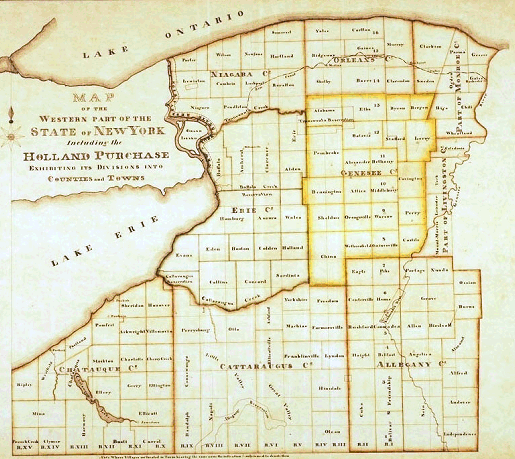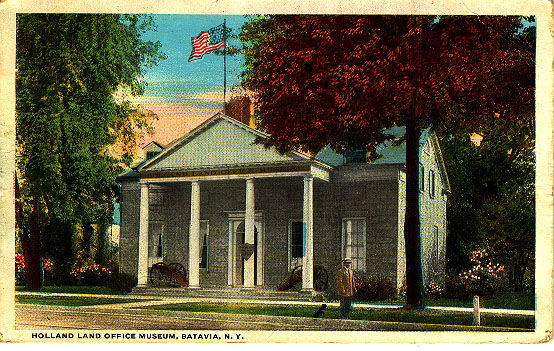Holland Land Company
|
|

Map of the Holland Purchase From 1840s
Divided into Counties and Townships
And Including Morris Reserve Lands
The Holland Land Company was a purchaser of the western two-thirds of the western New York land tract known as the Phelps and Gorham Purchase. This tract was known thereafter as The Holland Purchase. The Holland Land Company was actually an unincorporated syndicate of 13 Dutch investors in Amsterdam, that originally placed funds in the hands of certain trustees in America for the purpose of investing in land in central and western New York State and western Pennsylvania. Trustees were needed because aliens were not then permitted to own land. The syndicate hoped to sell the land rapidly at a great profit. Instead, for many years they had to put money into their purchase; surveying it, building roads and trying to make it attractive to settlers.
The tract purchased in western New York was a 3,250,000 acre (13,150 km²) portion of the Phelps and Gorham Purchase that lay west of the Genesee River. It was purchased in December 1792 and February and July 1793 from Robert Morris who had purchased it from Massachusetts in May 1791, after Phelps and Gorham failed to extinguish Indian title to this tract and had defaulted on payment in 1790. Morris’s purchase was actually for all lands west of the Genesee River except for the 185,000 acre (749 km²) Mill Yard Tract, which Phelps and Gorham retained, along with their other lands east of the Genesee. Morris paid Massachusetts $333,333.34. Morris' purchase from Massachusetts was for some 3,750,000 acres (15,200 km²), but Morris kept back some 500,000 acres (2,000 km²) for himself in a tract 12 miles wide (19 km) and running the breadth of western New York from Lake Ontario to the Pennsylvania. This 500,000 acre (2,000 km²) tract was known as the Morris Reserve.
WNY5.PNG
Image:WNY5.PNG
Map of Western New York
Showing Phelps & Gorham's Purchase
(including the Mill Yard Tract)
The Holland Purchase and the Morris Reserve
Before Morris could give the Holland Land Company title to this land, however, it was necessary to quiet the Indian title. This was not done until the 1797 Treaty of Big Tree. Big Tree was a place on the Genesee River near modern-day Geneseo, and south of Rochester, New York. Representatives of the Holland Land Company, of Robert Morris, of the Indians, along with a commissioner for the United States, gathered at Big Tree on the Genesee River in August, 1797 and negotiations began. Chiefs and Sachems present included Red Jacket, Cornplanter, Governor Blacksnake, Farmer's Brother and about 40 others. Red Jacket and Cornplanter spoke strongly against selling the land. They held out for "reservations," that is, land which the Indians would keep for their own use. After much discussion, the treaty was signed Sept. 15, 1797. The Native Indians were to receive $100,000 for their rights to about 3.75 million acres (15,000 km²), and they reserved about 200,000 acres (809 km²) for themselves.
In 1798, the New York Legislature authorized aliens to hold land directly, and the trustees conveyed the Holland Purchase to the real owners. It was transferred to two sets of proprietors, and one of these sets soon divided into two, making three sets of owners altogether. Each set of proprietors owned their tract s “joint tenants” with right of survivorship, which means as proprietors died off, the surviving proprietors took the deceased's share, and that share did not pass by will or inheritance, except in the case of the last survivor.
The first transfer by the trustees was all of the Holland Purchase except 300,000 acres (1,200 km²) and was to Wilhelm Willink, Nicholas Van Straphorst, Pieter Van Eeghen, Hendrick Vollenhoven, and Rutger Jan Schimmelpennick. The 300,000 acre (1,200 km²) remainder was conveyed to Wilhelm Willink, Wilhelm Willink, Jr., Jan Willink and Jan Willink, Jr. About two years after the first transfers, the proprietors of the large tract reconveyed title to the original five, plus Wilhelm Willink, Jr., Jan Willink, Jr., Jan Gabriel Van Straphorst, Roelif Van Straphorst, Jr., Cornelius Vollenhoven, Hendrick Seye and Pieter Stadnitski. Thus, there were 13 members of the Holland Land Company.
The Holland Land Company hired a general agent, Theophile Cazenove, who was located in Philadelphia, to oversee land sale. In 1798, Joseph Ellicott was hired and he, along with his brother Benjamin and 130 men surveyed the purchase for the next three years at a total cost of $70,921.69 1/2. In November, 1800, Paolo Busti (Paul Busti) succeeded Cazenove as General Agent. Busti was an Italian from Milan, Italy, who had married one of the syndicate member's sister. He would serve until his death in 1824.
The Holland Land Company's main land office was opened (1801) in Batavia, New York. Batavia was selected because the Holland Lands were all constituted Genesee County and Batavia was the county seat. Busti also appointed local agents at other offices in different parts of the Purchase. In about 1846, the affairs of the company in the United States were liquidated and the company dissolved.
The members of the Holland Land Company never travelled to America.

